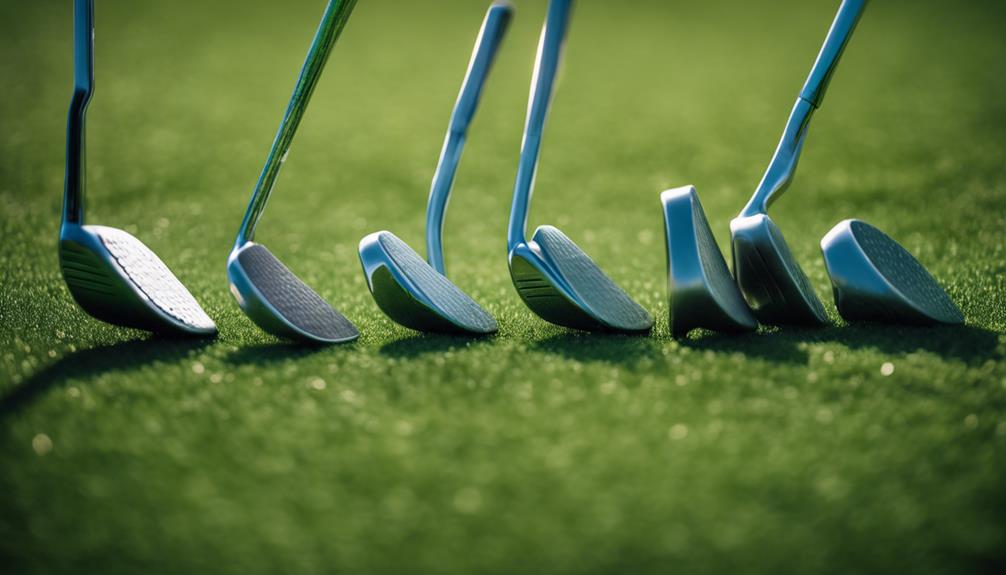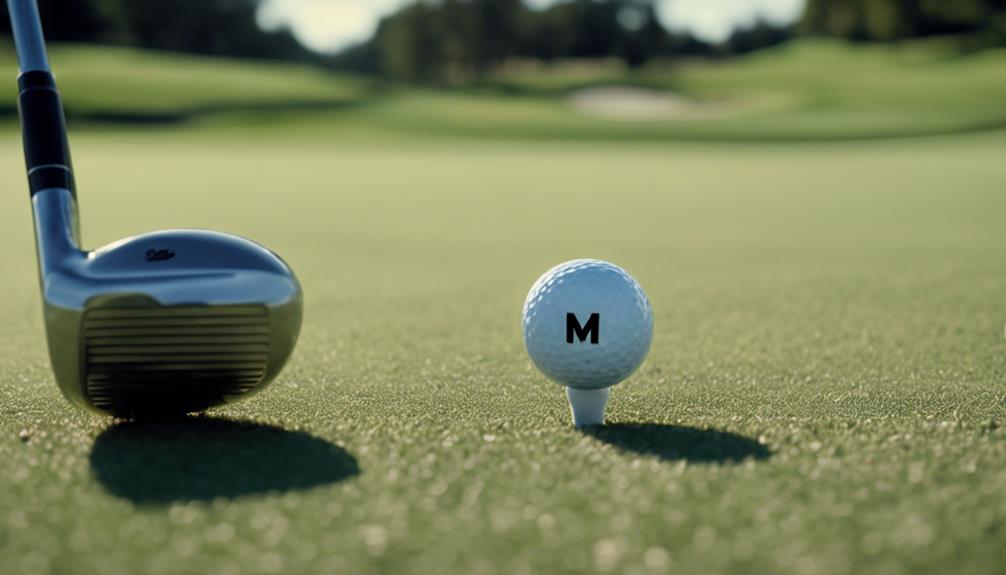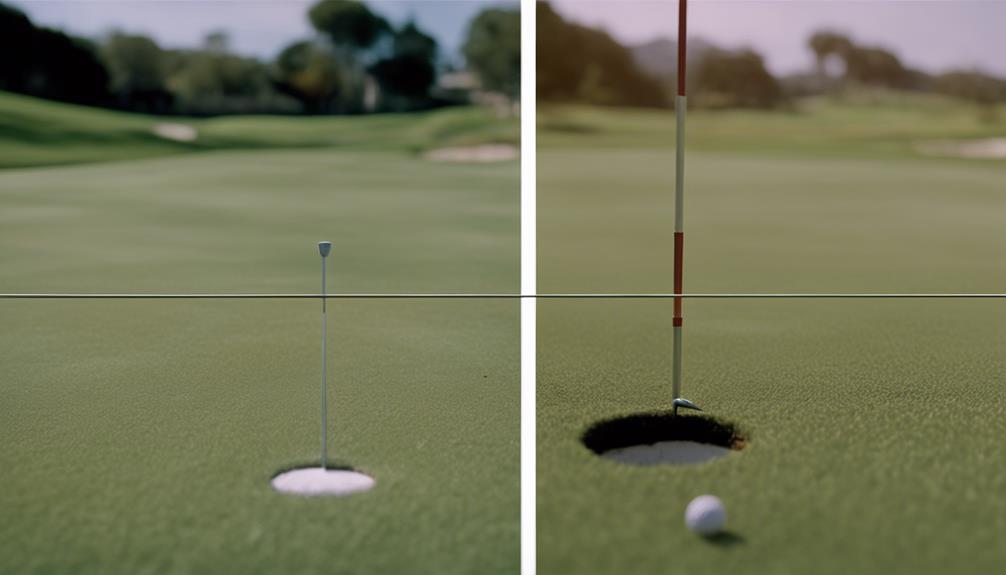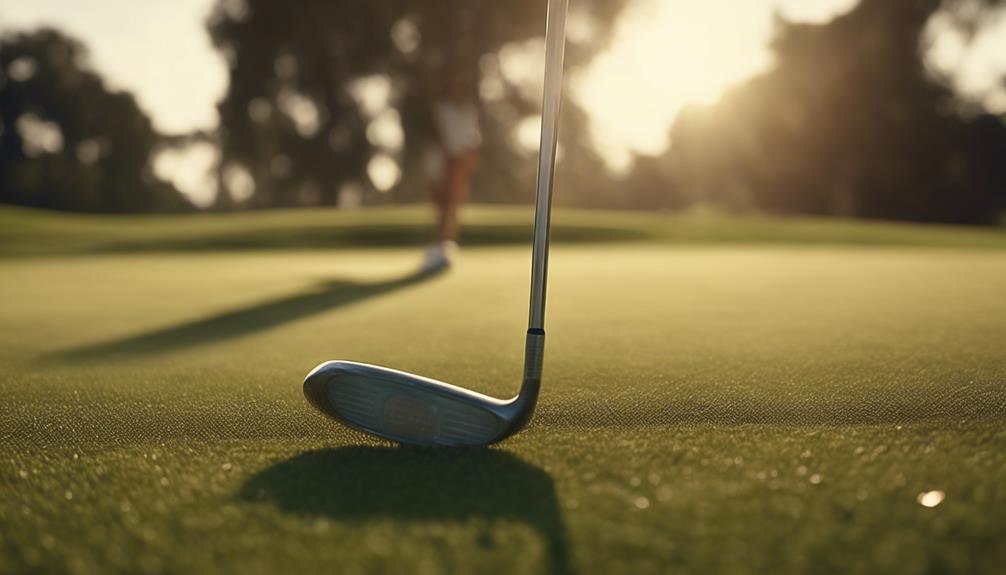- 7 Top Flite Golf Clubs XL for Improved Performance - September 28, 2024
- Top Flite Golf Clubs: Top 5 Reasons to Choose Them - September 28, 2024
- Top 3 Golf Club Fitters for a Perfect Swing - September 28, 2024
When you see the letter 'M' on a golf club, it usually indicates a versatile wedge designed for short approach shots. However, the designation can vary by manufacturer, so it's crucial to familiarize yourself with the specific notation used by your club's brand. In some cases, 'M' may represent a specific loft designation, while others may use it to signify a particular type of club. To make sure you're selecting the right club for your short game, take the time to understand the meaning of 'M' in the context of your club. As you explore further, you'll uncover the nuances of club designations and how they impact your game.
Key Takeaways
- 'M' on a golf club can denote a versatile wedge for short approach shots, but its meaning varies by manufacturer.
- In some brands, 'M' indicates a specific loft designation, emphasizing the importance of understanding manufacturer-specific notation.
- The 'M' designation can also stand for 'Medium' or 'Mature' in shaft flex codes, suitable for senior players or moderate swing speeds.
- Familiarity with brand-specific meanings of 'M' is crucial for proper club selection and effective short game strategy.
Understanding Golf Club Numbers
When you grasp the significance of golf club numbers, you'll reveal the secret to selecting the perfect club for your shot. These numbers hold the key to understanding the loft angle of the club face and its direct impact on the ball's trajectory and distance.
As you explore the different types of golf clubs, you'll notice that each number corresponds to a specific loft angle. Lower numbers, such as 3-iron, have less loft, allowing for longer distances at lower heights. In contrast, higher numbers, like 9-iron, provide more loft for a higher trajectory but shorter distance.
Understanding the loft associated with each club number is essential for making informed decisions about which club to use for different shots on the course. The loft of a golf club typically ranges from about 10 degrees for a driver (low number) to around 60 degrees for a lob wedge (high number), illustrating the wide spectrum of shot types available to golfers.
Meaning of the Letter M
As you explore the nuances of golf club notation, you'll likely encounter the enigmatic letter 'M', which often denotes a versatile wedge designed for short approach shots. The 'M' designation typically refers to a type of wedge, but its exact meaning can vary depending on the manufacturer.
In some cases, 'M' may represent a specific loft designation within a manufacturer's lineup, indicating the club's intended use. However, different brands may use 'M' to signify various club types, leading to some confusion regarding its exact meaning in different contexts.
It's crucial to understand the significance of 'M' to guarantee you select the appropriate club for your short game needs. You may encounter instances where 'M' is confused with 'W' for wedge, depending on the club model and manufacturer.
To avoid confusion, familiarize yourself with the specific notation used by your club's manufacturer. By doing so, you'll be able to decipher the meaning of 'M' and make informed decisions when choosing the right club for your game.
Common Wedge Types Explained

How do you navigate the various wedge types to find the right one for your short game needs? With so many options available, it's crucial to understand the characteristics of each wedge type to make an informed decision.
As you explore the world of golf clubs, Everything You Need to know about wedge types starts with the basics.
The Pitching Wedge (P) is a staple in most golfers' bags, used for shorter approach shots with a typical loft ranging from 44 to 48 degrees.
The Gap Wedge (G) fills the distance gap between a pitching wedge and a sand wedge, usually featuring a loft of 50 to 54 degrees.
The Approach Wedge (A) is designed for short, lofted shots around the green, typically with a loft between 50 to 54 degrees.
The Sand Wedge (S) is specifically designed for bunker play and shots from soft lies, generally having a loft between 54 to 58 degrees.
Additionally, some manufacturers, like TaylorMade, offer an Attack Wedge, similar to an Approach Wedge, for versatile short game shots.
Understanding these wedge types will help you choose the right golf club for your short game needs.
Manufacturer Variations in Naming
As you explore the world of golf clubs, you'll notice that different manufacturers use the letter 'M' to signify distinct club types.
However, you shouldn't assume that the 'M' designation means the same thing across brands, as each manufacturer has its own unique naming conventions.
To guarantee you're selecting the right club for your game, it's important to understand the specific meaning of 'M' and other designations in the context of each brand.
M Club Designations
Manufacturers like TaylorMade, Callaway, and Titleist employ distinct naming conventions for their golf clubs, often incorporating the letter 'M' to signify specific wedge designs that cater to particular playing styles and shot requirements.
As you explore M club designations, you'll notice that the letter 'M' typically indicates a wedge type, often with a specific loft for enhanced versatility in short approach shots. For instance, TaylorMade's Attack Wedge features an 'M' designation, setting it apart from standard naming conventions in the golf industry.
Other brands may use 'M' to signify clubs that fill the distance gap between pitching and sand wedges, although this can lead to confusion with other wedge types.
Understanding the significance of 'M' and other letter designations is essential for you to select the right club for your specific needs and shot types. By recognizing these variations, you'll be better equipped to navigate the diverse range of club types and make informed decisions to elevate your game.
Brand-Specific Lettering
You'll frequently encounter brand-specific lettering conventions in golf clubs, where the same letter can signify different club types or features depending on the manufacturer. This variation can lead to confusion among golfers, especially when it comes to understanding the meaning of a specific letter, like 'M', on a golf club.
For instance, TaylorMade's 'A' wedge is an Attack Wedge, whereas another manufacturer might use 'M' for a similar club. Ben Hogan's 'E' club, the Equalizer, functions like a pitching wedge, highlighting the inconsistency in naming conventions across brands.
It's crucial to recognize that the same letter can have different meanings depending on the manufacturer. When shopping for golf clubs or trying out a new set, you should verify the specifications to confirm you're getting the right club for your needs.
Don't assume that an 'M' club from one brand is the same as an 'M' club from another. Understanding these brand-specific codes will help you make informed decisions and improve your game. By being aware of these variations, you can focus on what really matters – mastering your swing and enjoying the game.
Importance of Correct Club Selection

When stepping onto the green, making the correct club selection is critical, as it directly impacts the accuracy and trajectory of your shot, and ultimately, your overall score.
You must consider your swing characteristics, course conditions, and the specific designations of your clubs to choose the right tool for the job.
Understanding the distance gaps between different types of wedges, such as the gap wedge (G) and pitching wedge (P), can greatly enhance your short game strategy and improve scoring opportunities.
By familiarizing yourself with the capabilities of each club, you'll develop a better feel for when to use them, leading to more effective club selection during play.
Remember, using a club with the appropriate loft can help achieve the desired trajectory and distance, so it's crucial to practice with various wedges to develop your skills.
Decoding Shaft Flex Codes
Golfers seeking to optimize their performance need to understand the cryptic codes on their shafts, particularly the 'M' designation, which holds the key to revealing their full potential.
When decoding shaft flex codes, you'll likely come across the letter 'M', which typically stands for 'Mature' or 'Medium'. This flex rating is suited for senior players or those with moderate swing speeds, typically ranging from 75 to 85 mph.
As an 'M' flex golfer, you prioritize accuracy and consistent shot distance over maximum power. This flex provides a balance between flexibility and control, allowing you to maintain a smooth swing while generating consistent results.
Properly matching your shaft flex to your swing characteristics is vital, as it can greatly enhance your performance and shot accuracy. Keep in mind that flex ratings can vary between manufacturers, so it's important to test different shafts before making a purchase.
Choosing the Right Flex for Your Swing

With a solid understanding of shaft flex codes, including the 'M' designation, it's time to determine which flex best suits your individual swing characteristics.
Every golfer needs to know that choosing the right flex is essential for optimizing performance, as mismatched flex can lead to difficulties in squaring the clubface and negatively impact shot trajectory.
Generally speaking, golfers with slower swing speeds (below 75 mph) benefit from using L flex shafts, while those with faster swings (110+ mph) may require X flex shafts for better control and distance.
If your swing speed falls between 85 and 95 mph, regular flex shafts (R) are suitable, while stiff flex (S) is ideal for speeds between 95 and 110 mph.
Senior flex shafts (A/M) cater to golfers with varying swing tempos and strengths, and are designed for swing speeds of 75 to 85 mph.
Don't forget to test different shaft flexes before purchase, as flex ratings aren't consistent across manufacturers.
Customization Features for Optimal Performance
As you explore the customization features of M/Speed clubs, you'll discover that Speed-Tuned Custom Heads are designed to optimize your performance.
By fine-tuning the head's shape and size, you can achieve the perfect balance of speed and accuracy for your swing.
Meanwhile, grip and shaft options allow you to further tailor your club to your individual style, ensuring a more consistent and powerful game.
Speed-Tuned Custom Heads
You'll benefit from Cobra's Speed-Tuned Custom Heads, which incorporate advanced features to match your swing dynamics and enhance performance.
By utilizing speed enhancement techniques, Cobra's customization process involves a thorough swing dynamics analysis to identify the ideal club specifications for your unique swing. This analysis enables custom fitting benefits, such as a one-degree closed face angle, which helps to improve ball loft and trajectory for moderate swing speeds. The result is a club tailored to your individual needs, ensuring you get the most out of your game.
With Cobra's Speed-Tuned Custom Heads, you'll experience enhanced performance, improved control, and increased distance. By pairing these custom heads with the right shaft and grip, you'll be able to take your game to the next level.
With a price tag of around $300, the investment in Cobra's M/Speed drivers is well worth it for golfers seeking mastery and peak performance.
Grip and Shaft Options
Customizing your grip and shaft is essential to revealing ideal performance, as these components greatly influence your overall swing dynamics and shot consistency.
When it comes to grip types, you'll notice that the M/Speed series features a 45D Durometer grip, providing a softer feel for maximum comfort and control. In contrast, the F/Speed series boasts a firmer 50D Durometer grip, offering enhanced feedback for golfers who prefer a more responsive feel.
Shaft weights also play a significant role in your game. The M/Speed shaft weighs in at 50 grams, designed with the Cobra/Aldila NV-M design, while the F/Speed shaft tips the scales at 55 grams, featuring the Cobra/Aldila NV-F design.
These variations cater to different swing speeds, ensuring you can find the perfect fit for your game. By customizing your grip and shaft, you can uncover significant benefits, including improved shot stability and accuracy, particularly if you have a faster swing tempo.
Performance Impact of M Speed and F Speed

When comparing the performance impact of M Speed and F Speed, golfers will find that the M Speed configuration is tailored to provide a more controlled launch, resulting in a more accurate and consistent ball flight. This is due to the M/Speed advantages, which cater to moderate swing characteristics.
Here are three key benefits of M/Speed performance:
- Optimized distance and control: M/Speed technology helps achieve an average driving distance of 210 to 250 yards, making it suitable for golfers seeking distance without sacrificing control.
- Improved accuracy: The one-degree closed face angle of M/Speed clubs promotes a lower launch angle, leading to a more accurate and consistent ball flight.
Pricing and Market Comparison
As you consider investing in an M/Speed or F/Speed golf club, you'll want to assess their market value and compare them to competitors.
You'll find that these clubs are priced competitively, with features like optimized grips and shafts justifying their cost.
Market Value Analysis
In the golf equipment market, you'll find that M and F series drivers are positioned competitively, priced around $300, which reflects their advanced technology and customization features that cater to various skill levels. This pricing strategy is influenced by market demand trends, where golfers are willing to invest in high-quality clubs that enhance their performance.
- Pricing Strategies Analysis: The $300 price point indicates a premium product, appealing to serious golfers seeking advanced technology and customization options.
- Consumer Behavior Insights: Golfers prioritize quality and effectiveness, driving demand for high-performance clubs that justify the investment.
Comparison to Competitors
You'll find that Cobra's M/Speed and F/Speed drivers hold their ground against competitors, offering advanced technology and customization options at a similar $300 price point. When compared to TaylorMade's drivers, Cobra's offerings stand out with their swing speed adaptations, providing tailored options for moderate and fast swingers.
| Cobra | TaylorMade |
|---|---|
| M/Speed and F/Speed drivers: $300 | Sim Max and Sim drivers: $300-$400 |
| Fairway clubs: $180 | Fairway clubs: $200-$300 |
| Woods: $130 | Woods: $150-$250 |
Cobra's pricing strategy emphasizes performance enhancement while remaining competitive in the market. By providing value through advanced technology and customization options, Cobra clubs offer a compelling alternative to premium-priced competitors. With their focus on swing speed adaptations, Cobra's drivers cater to a broader range of golfers, making them an attractive choice for those seeking mastery.
Applying Golf Club Knowledge in Practice

By mastering the nuances of golf club designations, you can greatly enhance your on-course decision-making and overall performance.
Applying golf club knowledge in practice involves understanding how different club numbers and lofts affect shot trajectory and distance. This knowledge can notably improve your decision-making on the course.
To take your game to the next level, focus on the following key areas:
- Club fitting techniques: Familiarize yourself with the specific characteristics of clubs, including the 'M' wedge's versatility for short approach shots.
- Shot trajectory analysis: Study how different clubs and lofts impact shot trajectory, enabling you to make informed decisions about which club to use in various situations.
Frequently Asked Questions
What Does M Mean in Golf?
When you see the M designation on a golf club, you're looking at a specialized wedge designed for versatility and precision, offering improved performance benefits in short approach shots, with varying loft degrees depending on the manufacturer.
What Does S Stand for on a Golf Club?
As you step into the golfing arena, you're likely wondering what "S" stands for on a golf club. Simply put, it represents Sand Wedge, a club type with a wider sole and higher bounce, offering Shaft Flexibility and precise Club Designations for mastering short game situations.
What Does P Mean on a Golf Club?
You're looking for the p designation meaning on a golf club, which typically stands for Pitching Wedge, offering p club types with 44-48 degrees of loft and p performance features like higher trajectories and quicker stopping power.
How to Tell if a Shaft Is Stiff or Regular?
You're wondering how to tell if a shaft is stiff or regular? Test its flexibility by applying pressure; a regular shaft will bend more, while a stiff one will barely flex, and consider your swing speed when choosing the right shaft for peak performance.
Conclusion
As you step onto the green, your understanding of golf club numbers is the key that opens up your full potential.
Just as a master chef wields their knives, you now hold the knowledge to select the perfect club, harnessing the power of the 'M' speed to slice through the competition.
With this newfound expertise, you're ready to tee off with confidence, steering through the course like a seasoned pro.




